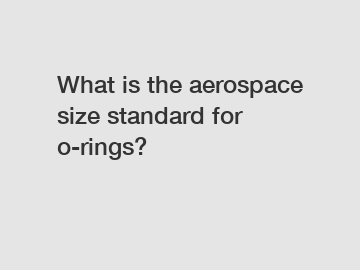What is the aerospace size standard for o-rings?
Aerospace Size Standard for O-Rings.
When it comes to aerospace applications, precision and reliability are of utmost importance. O-Rings play a critical role in ensuring that aerospace systems function as intended by providing a tight seal to prevent leakage of fluids or gases. To meet the stringent requirements of the aerospace industry, O-Rings must adhere to specific size standards. In this article, we will explore the aerospace size standard for O-Rings and why it is essential for aircraft and spacecraft.
**Aerospace Industry Requirements**.

The aerospace industry has unique requirements when it comes to components such as O-Rings. Due to the extreme conditions encountered in aerospace applications, including high temperatures, pressure differentials, and exposure to harsh chemicals, O-Rings must be designed and manufactured to withstand these challenges. In addition, the safety and performance of aerospace systems depend on the reliability of O-Rings to maintain a leak-free seal throughout the operational lifespan of the aircraft or spacecraft.
**Size Standard for O-Rings**.
The Aerospace Size Standard for O-Rings is defined by the Aerospace Standard AS568 published by the Society of Automotive Engineers (SAE). This standard provides a comprehensive list of O-Ring sizes, tolerances, and specifications that are commonly used in aerospace applications. By adhering to the AS568 standard, O-Ring manufacturers can ensure that their products meet the requirements of aerospace engineers and manufacturers.
**Benefits of Standardization**.
Standardization of O-Ring sizes in the aerospace industry offers several benefits. First and foremost, it ensures interchangeability of O-Ring components across different aerospace systems and manufacturers. This interchangeability is crucial for maintenance and repair activities, as it allows for easy replacement of O-Rings without the need for custom-made or non-standard parts.
In addition, adhering to a standardized size standard such as AS568 helps to streamline the design and manufacturing process. Engineers can select O-Rings from a predefined list of sizes, knowing that each size has been thoroughly tested and verified for performance in aerospace applications. This reduces lead times and costs associated with custom tooling and production processes.
**Quality Assurance in Aerospace Applications**.
In the aerospace industry, quality assurance is paramount to ensuring the safety and reliability of aircraft and spacecraft. By following the Aerospace Size Standard for O-Rings, manufacturers can demonstrate compliance with industry regulations and standards. O-Rings that meet the requirements of the AS568 standard have been designed and tested to withstand the rigors of aerospace environments, providing peace of mind to aerospace engineers and operators.
**Conclusion**.
In conclusion, the aerospace size standard for O-Rings, as defined by the AS568 standard, plays a crucial role in ensuring the performance and reliability of aerospace systems. By adhering to a standardized set of sizes, tolerances, and specifications, O-Ring manufacturers can provide aerospace engineers and manufacturers with high-quality components that meet the demanding requirements of the industry. Standardization not only simplifies the design and manufacturing process but also enhances interchangeability and quality assurance in aerospace applications.
For more information about O-Rings that meet aerospace size standards, please contact us.
If you want to learn more, please visit our website custom o ring wholesale, custom fkm tc oil seal price, custom fkm tc oil seal suppliers.
196
0
0

Comments
All Comments (0)